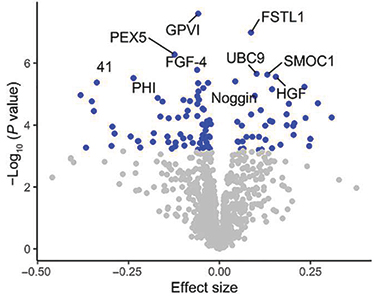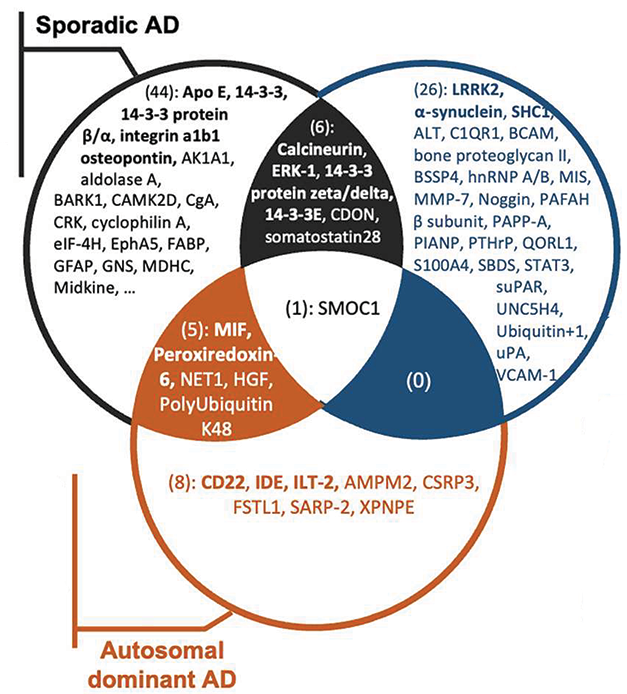Proteomics Discerns Sporadic from Familial Alzheimer’s Disease
Quick Links
While proteomic analysis enables scientists to explore what goes awry in Alzheimer’s disease, most studies have focused on brain tissue, cerebrospinal fluid, or plasma, or on sporadic versus familial forms of the disease. Taking a broader approach, researchers led by Carlos Cruchaga at the Washington University School of Medicine in St. Louis compared the proteomes of all three sample types among people who had sporadic Alzheimer’s disease, familial AD, or who carried TREM2 risk variants. In the July 5 Science Translational Medicine, they reported that, in people with sporadic AD, eight proteins in the brain, 40 in CSF, and nine in the blood were up or down relative to their levels in healthy controls. In people who had familial AD, 11 of those molecules were even more dysregulated, and another 98 ran amok. In TREM2 risk variant carriers, yet a different profile lit up, distinguishing them from controls and sporadic AD cases. This study marks the first proteomic analysis of TREM2 variant carriers. “It highlights that different processes lead to disease depending on the genetic background of the person,” Cruchaga told Alzforum.
- Though distinct, sporadic and familial AD proteomes share some similarities.
- Protein dysregulation is more severe in familial AD.
- Proteomes also distinguish carriers of TREM2 variants from noncarriers.
“This is great to see because much of what we know about TREM2’s role in AD is based on models, not patient data,” Betty Tijms and Pieter Jelle Visser of Amsterdam University Medical Center told Alzforum.
To capture the protein dynamics in AD, first author Yun Ju Sung measured proteomes in parietal cortex tissue from 290 people with sporadic AD, 24 with familial AD, 21 who carry TREM2 risk variants, and 25 controls. Sung used the SOMAscan assay, an aptamer-based platform that can detect 1,305 human proteins (Candia et al., 2017). She also analyzed the proteins in CSF from 176 sporadic AD cases, 289 familial AD cases, 47 TREM2 carriers, and 678 controls, as well as in the blood from 105 sporadic AD cases, 131 TREM2 carriers, and 254 controls. Participants were from the Knight AD Research Center and the Dominantly Inherited Alzheimer Network. Most were in their 70s or 80s, except for familial AD participants, who were mostly in their 50s.
Of the 1,305 proteins, 12 were up- or downregulated in sporadic AD brain, while 117 were dysregulated in the CSF, and 26 in the blood. The scientists compared their findings to changes reported in 10 independent, sporadic AD proteome studies: six of brain tissue, three of CSF, and one of plasma. Eight of the 12 proteins in the brain signature held up across these datasets, as did 40 of the 117 CSF proteins, and nine of the 26 plasma markers. In the brain and CSF proteomes, most proteins were upregulated, including the extracellular basement membrane protein SMOC1 in both signatures. The calcium-dependent phosphatase calcineurin and the members of the 14-3-3 regulatory/apoptosis family ticked up in the CSF. Most proteins in the plasma signature were downregulated, including ERK-1 and BARK1 kinases. Apolipoprotein B and the growth factor VEGF-D were upregulated (see image below).

Sporadic AD Proteome. Dozens of proteins (blue dots) are up- or downregulated in brain tissue (left), CSF (middle), and plasma (right) of people with sporadic AD. [Courtesy of Sung et al., Science Translational Medicine, 2023.]
To get a better idea what these sporadic AD changes mean, Sung identified functional pathways enriched by these up- and downregulated proteins. The sporadic AD proteins fell into pathways involved in neutrophil-mediated innate immunity, apoptosis, and, surprisingly, Parkinson’s disease, with the latter including differential expression of α-synuclein and the LRRK2 kinase. “This could explain why some AD patients have Lewy body pathology,” Cruchaga said.
Might the sporadic AD proteome be diagnostic? Levels of the eight proteins shared by all the brain tissue signatures distinguished people with sporadic AD from controls with an area under the curve of 0.84, while the 40 common CSF and nine blood proteins gave AUCs of 0.89 and 0.79, respectively. AUC measures sensitivity and specificity, with 1 being a perfect score.
How were the proteomes perturbed in people with familial AD? Of the 1,305 proteins, 109 were up- or downregulated in brain tissue compared to controls, of which 14 were also dysregulated in their CSF (see image below). Among them were SMOC1, macrophage migration inhibitory factor (MIF), and hepatocyte growth factor (HGF). Processes likely affected include proteolysis and innate immunity. As a panel, those 14 proteins in brain tissue distinguished people with familial AD from controls with a perfect AUC of 1, while a model based on CSF levels was 86 percent accurate.

Familial AD Proteome. In brain tissue from people who had had familial AD, 109 proteins (blue dots) were up- or downregulated compared to controls (left). [Courtesy of Sung et al., Science Translational Medicine, 2023.]
Notably, 11 of the 12 proteins altered in the brains of sporadic AD cases were upregulated to a greater extent in familial AD, by 36 percent on average. This highlights the aggressive nature of the autosomal-dominant disease, Cruchaga noted. “It also indicates shared mechanisms between sporadic and autosomal dominant AD,” said Tijms and Visser.
Researchers led by Charlotte Teunissen and Lisa Vermunt of Amsterdam UMC also recently reported similar CSF proteomes among people with familial and sporadic AD. Of 66 proteins dysregulated in the former, 34 were similarly dysregulated in the latter. Some proteins were the same as, or related to, those detected by Cruchaga, including MIF, HGF, and SMOC1's sibling SMOC2 (van der Ende et al., 2023).
Cruchaga expanded his analysis by turning to TREM2 variant carriers, who have triple the risk of developing AD than noncarriers (Nov 2012 news; reviewed by Ulrich and Holtzman, 2016). Compared to controls and sporadic AD cases, expression of five proteins was altered in TREM2 carrier brain tissue, seven in their CSF, and 21 in their blood. These proteins fell into pathways related to PD, autophagy, amyloid formation, and response to cytokines.

Different Proteomes—Different Diseases? Among 56 proteins dysregulated in sporadic AD, 14 in familial AD, and 33 in TREM2 variant carriers, only SMOC1 was dysregulated in all three conditions. [Courtesy of Sung et al., Science Translational Medicine, 2023.]
Again, the distinct proteome of TREM2 risk variant carriers turned out to have some diagnostic value. The panel of seven CSF proteins distinguished carriers from noncarriers and sporadic AD cases with AUCs of 0.79 and 0.84, respectively. For comparison, CSF phospho-tau181/Aβ42 ratios predicted TREM2 status versus controls or AD cases with AUCs of 0.74 and 0.53. Models using the 21 blood proteins performed even better, detecting carriers from controls or sporadic AD cases with accuracies of 93 and 90 percent, respectively, compared to CSF p-tau181/Aβ42 AUCs of 0.69 and 0.63. “We are creating prediction models that are better and more accurate based on the genetic background of the individual,” Cruchaga said.
Cruchaga plans to extend this proteomic analysis and diagnostic modeling to APOE4 carriers and people who have rare variants in the SORL1 gene. Together with colleagues in 20 labs across the U.S., the Netherlands, France, and Spain, he has formed the Global Neurodegeneration Proteomics Consortium (GNPC) to pool proteomics data on 70,000 plasma samples from people with or at risk of AD and related dementias, including frontotemporal dementia, dementia with Lewy bodies, and possibly even amyotrophic lateral sclerosis. “It will be quite comprehensive, including different APOE genotypes, TREM2 risk variant carriers, and so on, and will include cross-sectional and longitudinal samples,” Cruchaga said. So far, they have collected and are analyzing 40,000 samples.—Chelsea Weidman Burke
References
Mutation Interactive Images Citations
News Citations
Paper Citations
- Candia J, Cheung F, Kotliarov Y, Fantoni G, Sellers B, Griesman T, Huang J, Stuccio S, Zingone A, Ryan BM, Tsang JS, Biancotto A. Assessment of Variability in the SOMAscan Assay. Sci Rep. 2017 Oct 27;7(1):14248. PubMed.
- van der Ende EL, In 't Veld SG, Hanskamp I, van der Lee S, Dijkstra JI, Hok-A-Hin YS, Blujdea ER, van Swieten JC, Irwin DJ, Chen-Plotkin A, Hu WT, Lemstra AW, Pijnenburg YA, van der Flier WM, Del Campo M, Teunissen CE, Vermunt L. CSF proteomics in autosomal dominant Alzheimer's disease highlights parallels with sporadic disease. Brain. 2023 Nov 2;146(11):4495-4507. PubMed.
- Ulrich JD, Holtzman DM. TREM2 Function in Alzheimer's Disease and Neurodegeneration. ACS Chem Neurosci. 2016 Apr 20;7(4):420-7. Epub 2016 Feb 19 PubMed.
Further Reading
Primary Papers
- Sung YJ, Yang C, Norton J, Johnson M, Fagan A, Bateman RJ, Perrin RJ, Morris JC, Farlow MR, Chhatwal JP, Schofield PR, Chui H, Wang F, Novotny B, Eteleeb A, Karch C, Schindler SE, Rhinn H, Johnson EC, Oh HS, Rutledge JE, Dammer EB, Seyfried NT, Wyss-Coray T, Harari O, Cruchaga C. Proteomics of brain, CSF, and plasma identifies molecular signatures for distinguishing sporadic and genetic Alzheimer's disease. Sci Transl Med. 2023 Jul 5;15(703):eabq5923. PubMed.
Annotate
To make an annotation you must Login or Register.

Comments
No Available Comments
Make a Comment
To make a comment you must login or register.